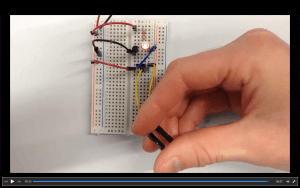Sunday 31 March 2019
Friday 29 March 2019
Engineering for high-speed devices
Thursday 28 March 2019
A rubber computer eliminates the last hard components from soft robots
New approach could boost energy capacity of lithium batteries
Wednesday 27 March 2019
Metal nanoclusters can be used as semiconductors: Key properties observed for first time
Spintronics: Ultra-short spin waves in an astoundingly simple material
3D printer threads electronic fibers onto fabrics
Tuesday 26 March 2019
New cellulose-based material gives three sensors in one
New 3-D printing approach makes cell-scale lattice structures
CRISPR-chip enables digital detection of DNA without amplification
Friday 22 March 2019
Developing new organic materials for electronics
Thursday 21 March 2019
Organic semiconductors: One transistor for all purposes
Researchers boost intensity of nanowire LEDs
True-meaning wearable displays: Self-powered, washable and wearable
Engineers demonstrate metamaterials that can solve equations
Wednesday 20 March 2019
The best topological conductor yet: Spiraling crystal is the key to exotic discovery
Fish-inspired material changes color using nanocolumns
Tuesday 19 March 2019
Researchers discover new material to help power electronics
Monday 18 March 2019
Advances point the way to smaller, safer batteries
Water-resistant electronic skin with self-healing abilities created
Sunday 17 March 2019
Absorbable antibiotic envelope can significantly cut cardiac device infections
Friday 15 March 2019
Research set to shake up space missions
Thursday 14 March 2019
Renewable energy won't make Bitcoin 'green,' but tweaking its mining mechanism might
New technology accelerates the science of deceleration
Wednesday 13 March 2019
Powering devices -- with a desk lamp?
Tuesday 12 March 2019
Movie technology inspires wearable liquid unit that aims to harvest energy
Monday 11 March 2019
Ultrathin and ultrafast: Scientists pioneer new technique for two-dimensional material analysis
Controlling thermal conductivity of polymers with light
Mechanized cane measures patients' rehabilitation process without noticing it
Friday 8 March 2019
The moiré patterns of three layers change the electronic properties of graphene
Thursday 7 March 2019
Ultra-low power chips help make small robots more capable
Breakthrough could enable cheaper infrared cameras
When semiconductors stick together, materials go quantum
Wednesday 6 March 2019
Light from an exotic crystal semiconductor could lead to better solar cells
Researchers aim for spintronic applications thanks to great leap forward
1 + 1 does not equal 2 for graphene-like 2D materials
One device, many frequencies: Researchers create a unique, tiny resonator
Tuesday 5 March 2019
Scientists study neutron scattering for researching magnetic materials
Nanoparticles help realize 'spintronic' devices
Monday 4 March 2019
Magnonic devices can replace electronics without much noise
12V can break your circuit
 More than 15 years ago, I was sitting in the basement of my parents’ house.
More than 15 years ago, I was sitting in the basement of my parents’ house.
A friend and I were soldering LEDs.
The smell of melted solder was surrounding us, and Eminem’s album “The Marshall Matters LP” was pumping from the speakers.
We were really enjoying ourselves.
I didn’t know much electronics.
But I had found a schematic diagram that showed how to build a running light strip with LEDs.
“Russetiden” was only a couple of weeks away.
It is a tradition in Norway where those who are graduating high school celebrate.
Usually by driving around the city in a red car or a bus for 17 days straight.
We had to get the LED strip to work by then!
It was going to attach to the roof inside of our bus to make it look really cool.
In the basement, we tested the circuit with a 9V battery and everything seemed to work just fine.
The day before the festive time, I was going to install the LED strip in the bus.
…but there was one thing I had forgotten to think about:
Power supply.
In the bus, there was only a 12V output.
Since 12V is not THAT much more than 9V, I figure it would probably work.
So, I connected the 12V to the LED strip…
A bright light in all the LEDs lit up, then some smoke came up and it died.
“NOOOOO!”
We had spent several weeks on this, now I had destroyed it in a couple of seconds.
…
What I learned from that was that it is smart to stick with the specified voltage. Even though 12V is just a little bit more than 9V, it was enough to ruin the circuit.
If I only had some basic knowledge about Ohm’s law, resistors and LEDs, I could have avoided it.
Very simple stuff, but when you don’t know it, it can destroy the project you’ve put so much time into.
Do you have a good understanding of how resistors, LEDs, and currents work?
If not, I really recommend checking out the Ohmify membership. You’ll learn the theory that you will actually need, and you’ll get to practice building lots of cool circuits.
For example a robot, a music player, or a kitchen timer. Learn more here:
Keep On Soldering!
Oyvind @ build-electronic-circuits.com
Copyright Build Electronic Circuits
Saturday 2 March 2019
Friday 1 March 2019
Organic electronics: Scientists develop a high-performance unipolar n-type thin-film transistor
Key to efficient and stable organic solar cells
A team of researchers has made a significant breakthrough in the field of organic photovoltaics.
-
Do you need a MOSFET gate resistor? What value should it be? And should it go before or after the pulldown resistor? If you’re a bit impati...
-
I was first introduced to logic gates when I was around 14 years old. I had heard that computers consisted of ones and zeroes. But I didn’t...
-
A self-powered sensor could allow doctors to remotely monitor the recovery of surgical patients. The small, tube-like device is designed to ...